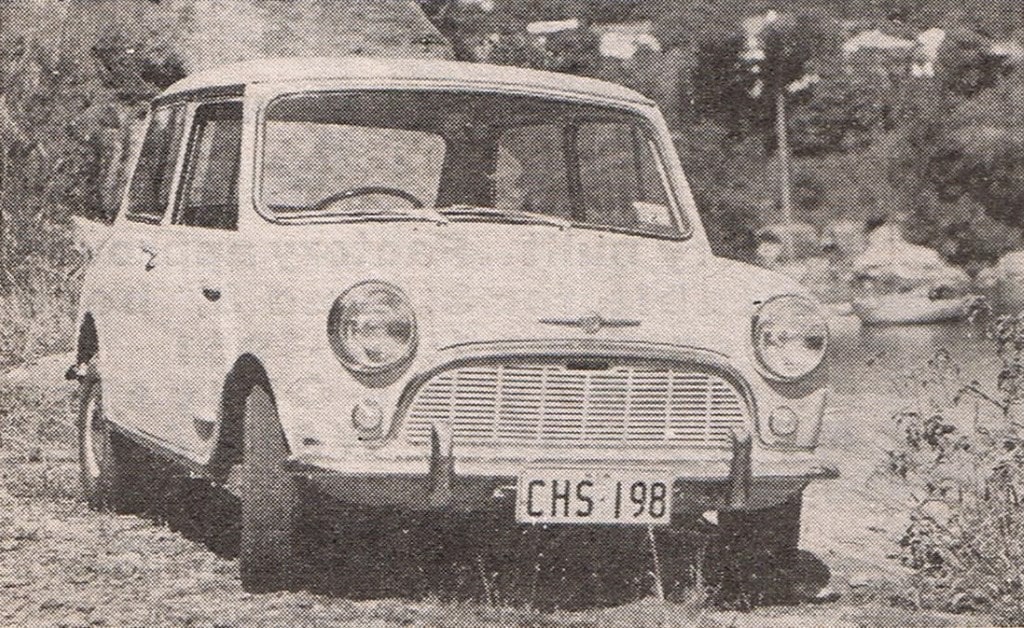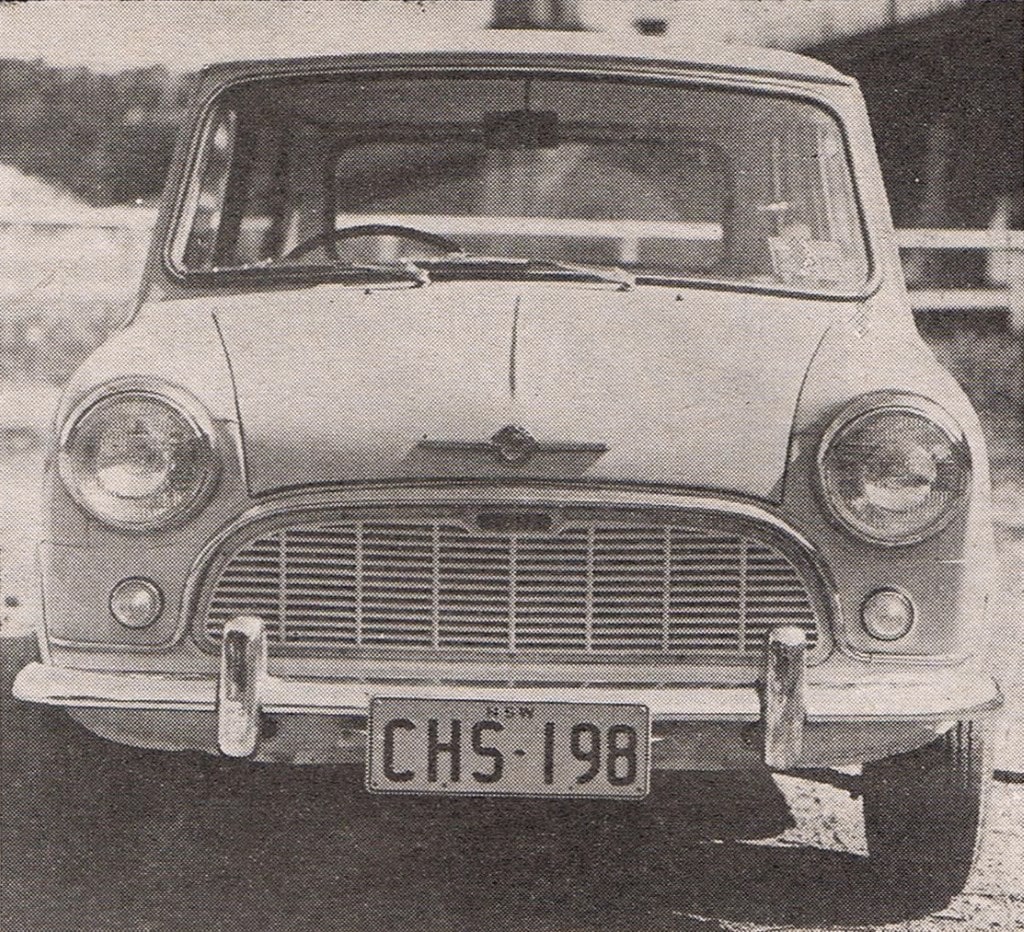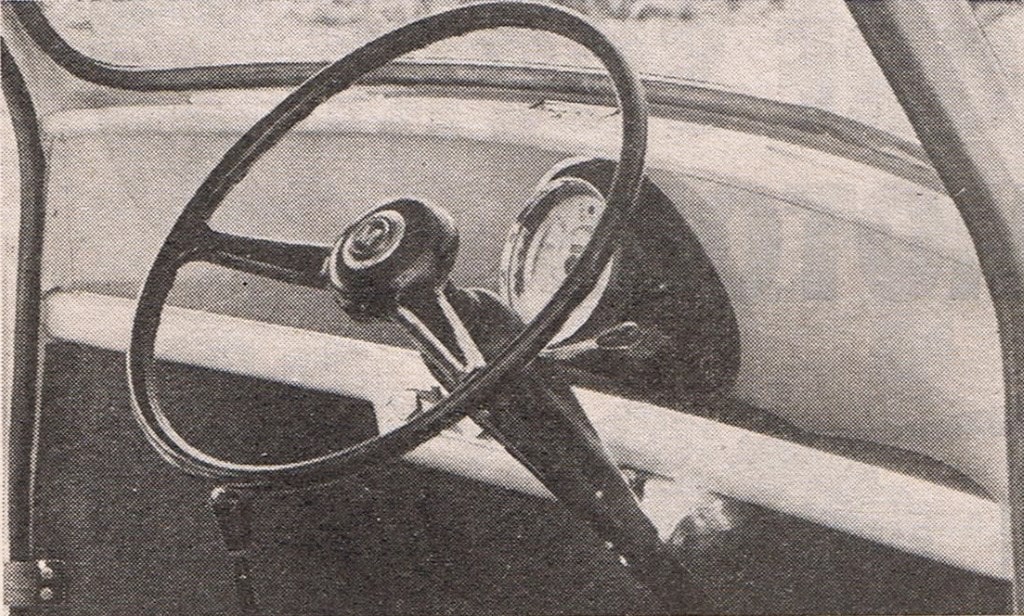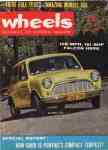
Morris' Mercurial Marvellous 850
Wheels - May, 1961
Wheels - May, 1961
Here at last, the Morris 850 paves the way for future developments in the small car field. Selling for a mere £775, this looks like most exciting car for 1961.
By Ian Fraser
FIRST and foremost thing about the Morris 850 is to totally ignore the fact that it looks small. In external dimensions it is small and anyone who tries to kid you that it's any other way is not telling the truth.
However, don't be fooled into thinking that a baby car is necessarily small in other ways.
First things first, though. Let's take a look at this car which, in England, sells under the name of Mini-Minor. It should already be known to many of our regular readers who have no doubt read reports about the car from our overseas correspondents.
The appearance of the car is probably one of its most debatable points. Some people look aghast, while others admit that it is practical if nothing else. On the other hand women are almost universal in their acclamation of the 850.
“Cute,” “darling little car,” “isn't it sweet" were just some of the comments I heard from the fairer sex.
Aware that the new Morris is something different, the British Motor Corporation has been daring with colors for the car. Our test car was a nice light blue, but you can have white, yellow or red. With such colors how can the 850 be ignored?
However, colors and looks don't sell cars. The more you look at the 850, the more obvious it becomes, that this vehicle is one of the most remarkable cars ever produced by anyone, anywhere, at any price.

The appearance of the Morris 850 is one of its debatable points. Although not handsome, it is not exactly ugly, either. It is a favorite with women.
The work of that brilliant engineer Alec Issigonis (he designed the Morris Minor, too) the 850 is closer in concept to a real 1961 car. That is a four-wheeled vehicle designed to carry people comfortably and swiftly at low cost. Issigonis saw what had to be done and did it.
No less than 75 per cent of the total space in the car is consumed in passenger space. The mechanical components take a minor place up front. To overcome any difficulties caused by the transmission tunnel interfering with the passenger space, the car has front wheel drive — the logical opposite to having a rear engine and rear wheel drive.
To achieve the ultimate aim in keeping the car to a modest size-10 ft 0½ in overall length — the design allows for the engine to be placed transversely across the front. The gearbox churns away in the sump and the gear lever sticks straight out of it. In effect, a power package.
I know it sounds an unbelievable arrangement, but when you come to think about it what could be more logical than having all the mechanicals combined as one unit, thus simplifying everything from manufacturer to service.
As far as I could see there seemed to be no serious drawback to this design other than the fact that water from the road can be admitted to the engine compartment through the grille and is a potential engine stopper. However, BMC has gone to the trouble of packing the electrics with silicone grease which, they say, lasts for many thousands of miles. People who regularly plough through river crossings in the country would probably find it necessary to take further measures, but normal motorists should get along okay.
On the discussion of the motor, everything is beautifully accessible under the bonnet and low enough to simply drop your hand in to get at things. The radiator itself is mounted on the passenger's side of the car and is fitted with a 16 (yes, that's right) blade fan which, besides doing an effective cooling job, eliminates the roar found in the English-made models.
When BMC first considered bringing the 850 to Australia, they first of all imported three or four for experimental purposes. I had the opportunity of driving one of these cars but was disappointed to find that it was rather noisy on the road. The engine roared—or rather the fan roared — and road noise was transmitted into the body.
However, the Australian engineers have gone to a great deal of trouble to silence the car to a level which is not likely to offend old ladies and people with soft voices. The 850 is now as quiet as can be expected from a modern motor car built to a price. Certainly is more silent than some of its competitors.
Powered by an engine of 848 cc, which is actually a destroked version of the Minor 1000, it develops 37 bhp (gross) at 5500 rpm—ample for a car with an unladen kerb weight of 11½ cwt.
I don't think anyone can be critical of the power unit. It is smooth in operation and very willing to rev furiously when the driver stamps hard on the accelerator. In spite of the 8.3 to 1 compression ratio it runs sweetly on supergrade fuel and at no stage did I encounter pinging when the car was under load.
For a small car equipped with a self-contained power-pack, there is a good case to have it in the rear rather than the front. On the other hand the same handling problems are not evident, there is less complication with controls and the car can have a conventional luggage boot, which may swing buyers from one side of the fence to the other.

Transversely mounted, the engine drives the front wheels through a four speed gearbox in the sump. Of 850 cc the engine has ample power.

Because the engine is transverse, the bonnet is remarkably small. Note the size of the windscreen which gives good forward visibility.
Independent suspension on all wheels is employed. Springs as such are absent. Instead, there are four highly resilient rubber cones, the resistance in which builds up according to the load carried. The life of the units is said to be almost indefinite —longer, in fact, than normal coils. The suspension units are used in conjunction with normal telescopic shock absorbers.
A striking thing at first glance is the smallness of the wheels which carry tubeless 5.20 by 10 tyres. However, on the roads I don't think it would be possible to tell the difference between these and say, 13 inch wheels. Over the roughest parts of our test course the wheels tumbled into and over potholes and rocks, but never once did I encounter any serious jarring and thumping. Over corrugations there was a slight tendency for the ride to be choppy.
Handling on the rough section of the test course was better than any other car I can recollect. With the power on the 850 shot around the corners — most of them downhill —without the slightest fuss or bother, but with a fair degree of understeer. Just as long as the power was kept on, the handling was above reproach. The whole secret of driving an 850 fast is to make sure you keep your right foot hard down on the go pedal. If you are really hammering through a corner and ease off the power, understeer turns to oversteer and makes the car feel unstable. Tramp on the power again and it comes good without hesitation. The tail, by the way, always follows faithfully behind and I could just not shake it loose.
At one stage during the test I had the chance to drive the Morris over some recently wet and very, very greasy roads. I found a deserted roundabout and flung the long suffering 850 into it flat out in second. Although the inside front wheel spun slightly, the car felt perfectly stable and refused to slide.
In the Morris 850 you feel as though you are a strong candidate for the World Championship for drivers. Very few cars impart the same feeling of trust and confidence that you get in the 850. What other cars gain on the straights, the baby makes up on the corners. Quite obviously there is a limit as to how hard you can go around a corner in any car, but I venture to say that a well-driven 850 would be almost impossible to catch on a twisty road.
Front wheel does have its peculiarities in handling, but taken overall it is much better than conventional systems of rear drive. For instance, rear-engined cars generally have to be treated with a certain amount of respect until the driver gets used to the handling, but in the 850 a driver can feel completely at home in a matter of a few miles.
The steering of the 850 is by rack and pinion. In spite of the fwd there is very little reaction through the steering wheel, as is common with many cars using this kind of drive. The only time I was actually aware that the front wheels were the driven ones was when the car was accelerating hard out of a tight corner in second gear. Even then the reaction was only slight.
Directional stability in high cross winds was good with the power on, although I did notice a slight tendency to wander when the power was off.
Of the handling this can be said: to make the car go around a corner, just point the front wheels in the desired direction of the travel and press hard on the accelerator. In other words, you press the buttons, the Morris does the rest.
Unlike most small cars I have driven, speed is difficult to judge without the aid of the speedo. On several occasions I found myself driving away past the speed limit without being aware of it. In traffic the car's good acceleration and ability to slip in and out of the most unlikely looking spaces are a constant temptation. In fact, it is very hard not to throw the car around in a most vigorous fashion. For town use the brakes are good and combined with the high geared steering (two and a third turns lock to lock for a 30 foot circle) make for exceptional manoeuvrability. For parking and turning in narrow streets, the steering lock seems to be comparatively big, which it is for a car 10 feet long. The restriction is, of course, the price paid for front wheel drive. If you remember, Citroens have been plagued with this problem in the past caused through the limitations of the constant speed universals.
However, for anyone used to driving a normal sized car, the 850 would come as a revelation. It is just the kind of car you jump into and drive off anywhere, confident that it will go reliably, economically and quickly and when you get there you can be reasonably assured of easy parking.
On paper the performance of the 850 is not breathtaking by any means, but it is as good as some 1500 cc cars and about 60 percent better than any other car of comparable size. Examining the economy of the car, I found that driven in a manner which permits moderately fast average speeds to be maintained over relatively long distances, the 850 is not only faster than most, but also more economical. Driven flat out on a long trip with four people and luggage aboard. I was staggered to get a return of 38 mpg on one tankful and as the traffic thickened up and reduced the average speed, this consumption improved to 42 mpg. I daresay that careful driving would return perhaps 50 mpg. Normal driving conditions with two people aboard would probably result in 45 mpg.

The luggage compartment is a moderate size and for bulky objects the tray can be left down. That's the fuel tank on the far left side.
BMC's aim in producing the 850 has been to sell a car which is cheap, economical and roomy, hence certain sacrifices have had to be made. One of them is sliding, instead of wind¬up windows. I know some of my readers are going to shudder and mutter judgment on motor manufacturers in general for doing this. When I first realised that 850 was so equipped I uttered things for which I am now sorry. In many ways the sliding windows are better than some wind-up types that I have had experience with. For instance, the 850's can be opened like lightning when you have to give a hand signal in a hurry to say nothing of the bonus in reduced weight and increased space in the doors for storage. It is easy to put your head out the window for reversing and as long as you don't bring it back in too much of a hurry there is no danger of loosing your ears.
The fact that the dashboard has only one instrument is a concession to economy as are the windscreen wipers which must be parked manually, although the fitting of a windscreen washer as standard is a step in the right direction considering that the screen is very prone to collect muck from other cars in wet weather.
The driving position itself was quite satisfactory, although the steering column is at a sharp angle. The pedals are well placed and the handbrake is between the seats. The speedo, well calibrated and moderately accurate, is easy to read. It was necessary to lean well forward to operate the switch gear and even further forward to flick out the speedo light. An interior light is fitted to the pillar just above the passenger's head, but it must be worked manually. Brickbats for the size of the rear vision mirror which failed to give an adequate view astern through the large window. And the trafficator warning light was far, far too bright at night.
Looking at the 850 (although I will always think of it as the Mini-Minor) objectively, I must first warn readers not to regard this as a small car in the accepted sense. It has big performance and is big inside. It is a completely sensible approach to the problem of motoring in 1961. As far as I can see it has no disadvantages whatsoever and the advantages make it a sensation for £775.
Finding a place for it on the motoring scene is not easy since at the time of writing the car had not been released. However, I know that the car is going to appeal to those people who genuinely want to move with the times—this is a very modern car. Frankly, an outstanding car of outstanding value whichever way you look at it. Even the most cynical of us will find motoring a pleasure in this car.

Both the doors have enormous pockets made possible by the fact that the windows slide. There are similar compartments for the back passengers.

The Morris 850's instrument panel could hardly be more simple. There is only one dial, the speedo, which incorporates a small fuel gauge.
SPECIFICATIONS
MAKE: Morris 850
PRICE: £775.
AVAILABILITY: Delays in most areas.
ENGINE: Cylinders, four; pattern, in line, water cooled; valves, pushrod overhead; bore and stroke, 62.9 mm by 68.26 mm; capacity, 848 cc; compression ratio, 8.3 to 1; bhp, 37 (gross) at 5500 rpm; torque, 44 lb/ft at 2900 rpm; carburettor, SU; fuel pump, SU electric; capacities; fuel, 5½ gals; 5¼ pints; radiator, 8½ pints.
TRANSMISSION: Type, four speeds with synchromesh on upper three ratios, running in the sump of the engine; propeller shaft, nil; front wheel drive. Ratios, top gear, 3.765; third, 5.317; second, 8.176; first, 13.657; reverse, 13.657. Final drive, 3.765.
BODY AND CHASSIS: All steel unitary construction, two-door bodywork.
SUSPENSION: Front, independent by transverse unequal wishbones and Mouton rubber springs. Rear, independent by trailing links and Mouton rubber springs. Shock absorbers telescopic.
BRAKES: Lockheed hydraulic with 67.5 sq in. Mechanical handbrake.
STEERING: Rack and pinion; lock, 30 ft; turns lock to lock, 2 1/3.
ELECTRICAL EQUIPMENT: Voltage, 12. Standard features, wipers, winkers, one interior light, one parcels tray light.
WHEELS AND TYRES: Type, steel disc. Tyre size, 5.20 by 10 tubeless.
DIMENSIONS: Wheelbase, 6 ft 8 in; track, front, 3 ft 11½ in; rear, 3 ft 10 in. Overall length, 10 ft 0½ in: overall width, 4 ft 7½ in; overall height, 4 ft 5 in; ground clearance, 6 in.
PERFORMANCE
TOP SPEED: Average of all runs, 73.4 mph; fastest one way, 74.8 mph.
MAXIMUM SPEED IN GEARS: 1st, 26 mph; 2nd, 42 mph; 3rd, 63 mph; 4th, 74.8 mph.
ACCELERATION: Standing quarter-mile, average, 23.2 sec; best time, 22.7 sec; through gears, 0-30, 6.5 sec; 0-40, 10.1 sec; 0-50, 16.2 sec; 0-60, 25.7 sec; top gear, 20-40, 13.7 sec; 40-60, 20.3 sec.
SPEEDOMETER CALIBRATIONS: Indicated 30 mph, actual 28 mph; indic 40 mph, actual 38 mph; indic 50 mph, actual 47 mph; indic 60 mph, actual 56 mph.
TAPLEY READINGS: Maximum pull in gears: 2nd, 415 lb/ton; 3rd, 275 lb/ton; 4th, 185 lb/ton.
BRAKE FADE: Slight after gorge-side descent, quick recuperation.
FUEL CONSUMPTION: Special highway test, cruising speeds, 45 mpg; overall, including performance checks, 40.1 mpg.
TEST WEIGHT: With test gear and two occupants, tanks full, 15½ cwt, 12 cwt dry.
TEST CONDITIONS: Weather, fine and warm. Moderate winds. Surface: All performance figures recorded on level, bitumen-bonded gravel surface. Figures averaged from several runs in opposite directions over measured strip. Acceleration figures recorded on corrected speedometer.
TEST CAR FROM: BMC (Australia).

Wheels
MAY 1961
This article was originally published in the May, 1961 edition of Wheels magazine.
Last updated 18 January 2024
